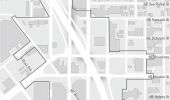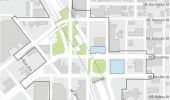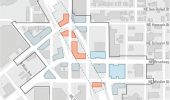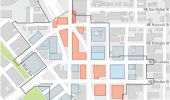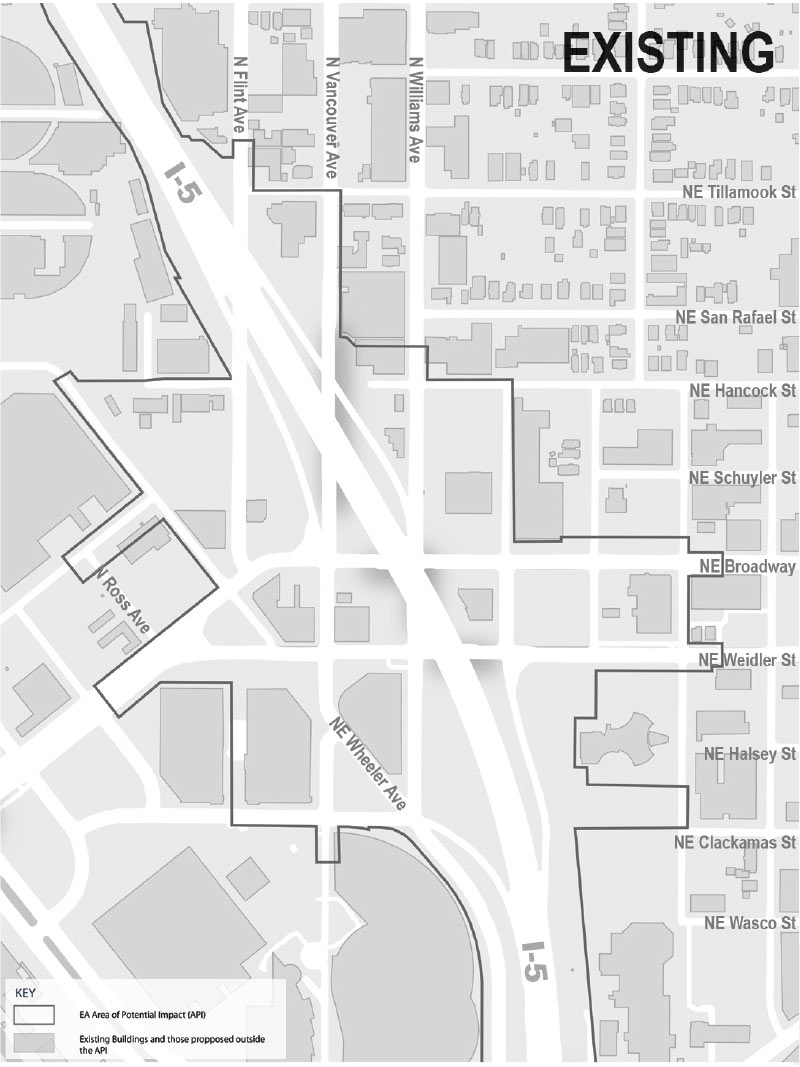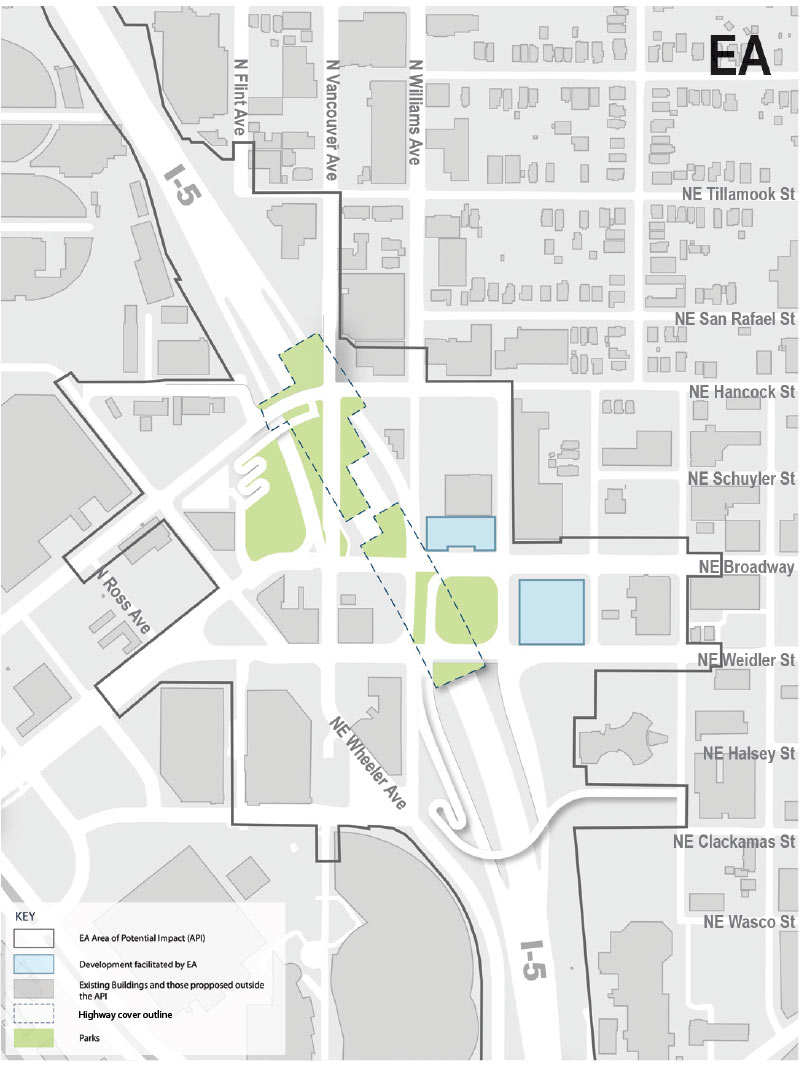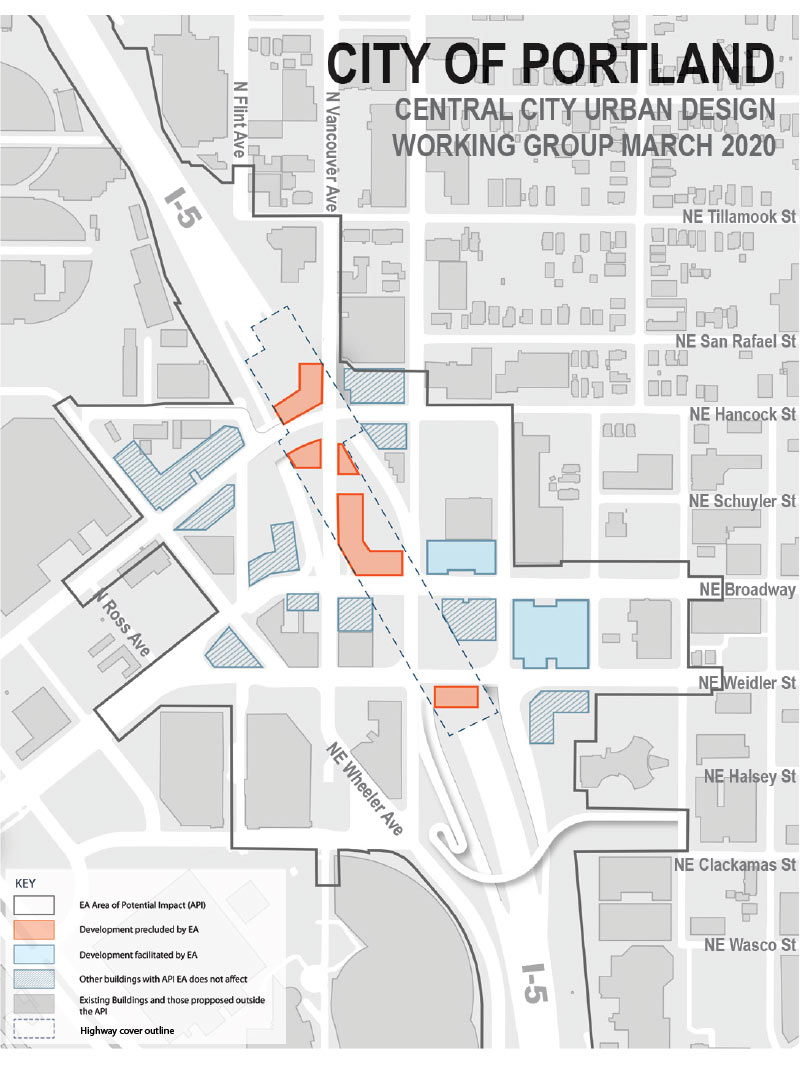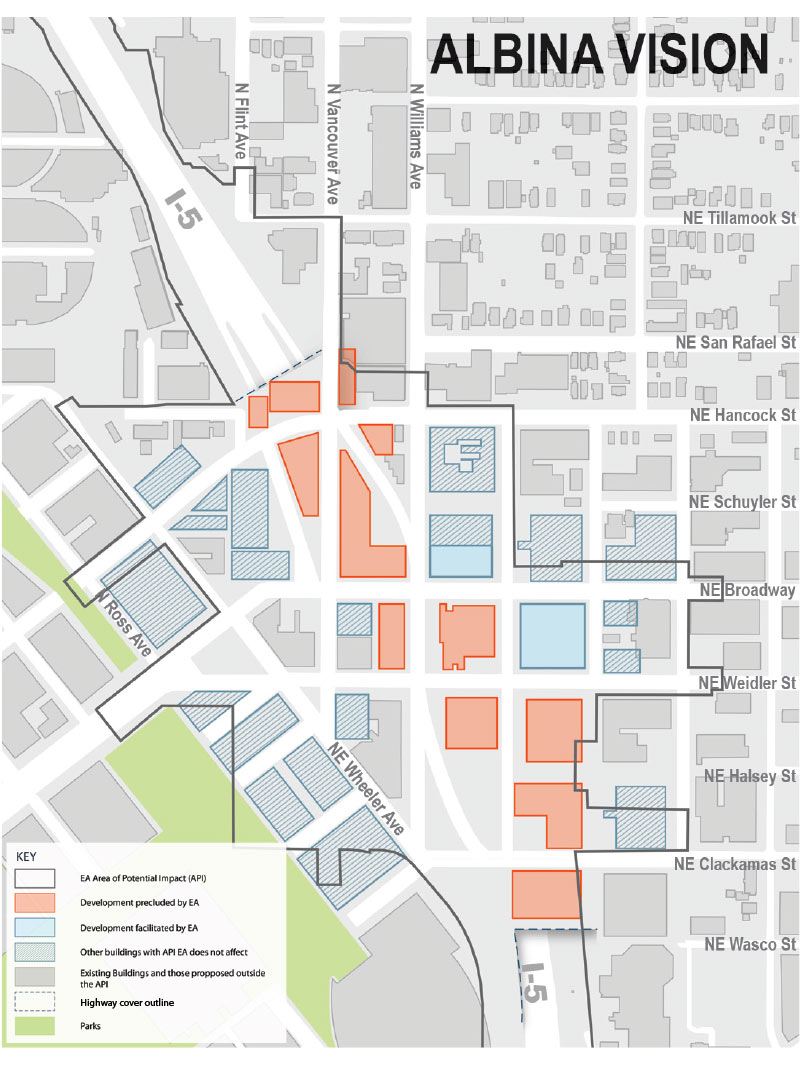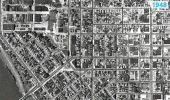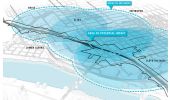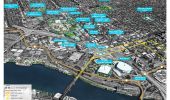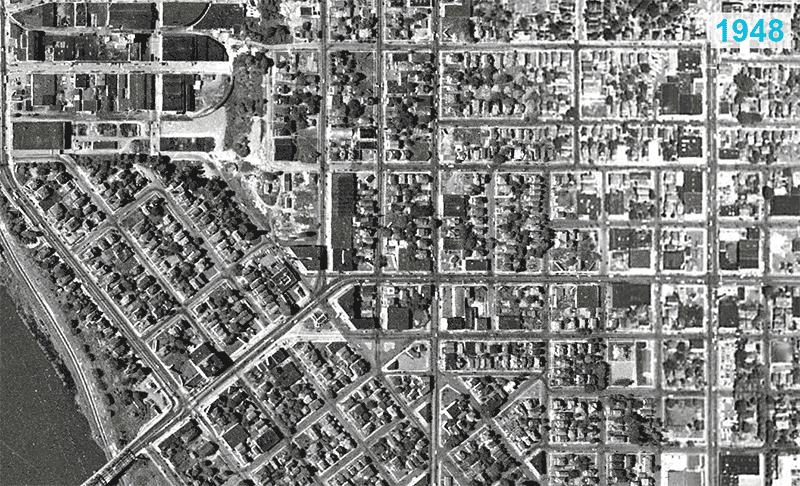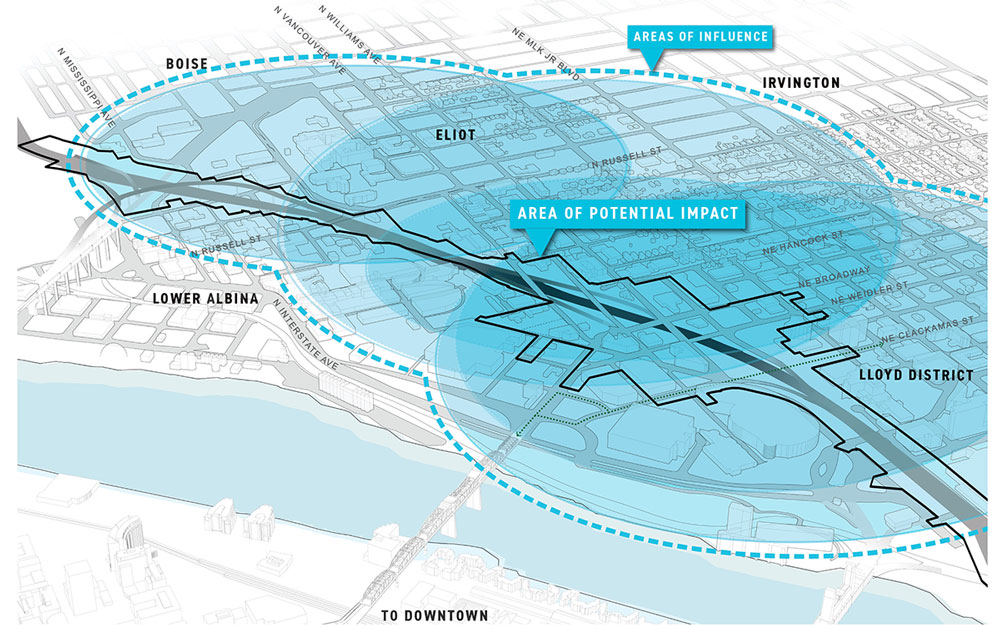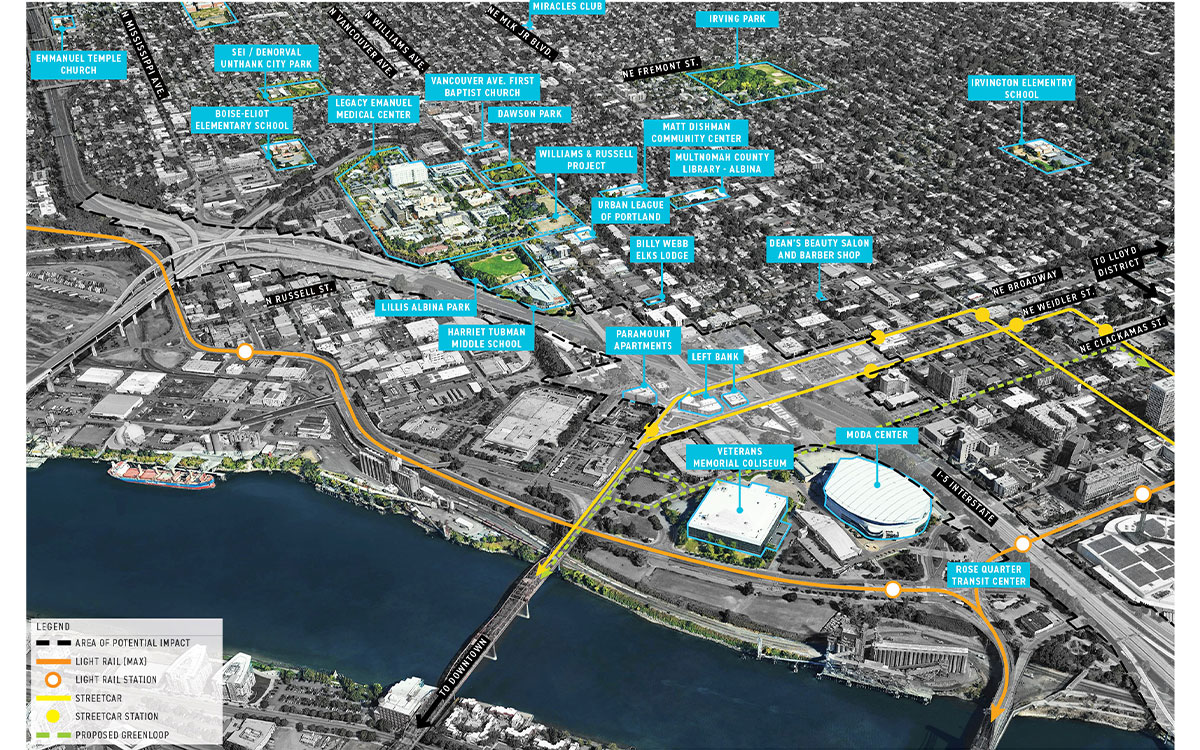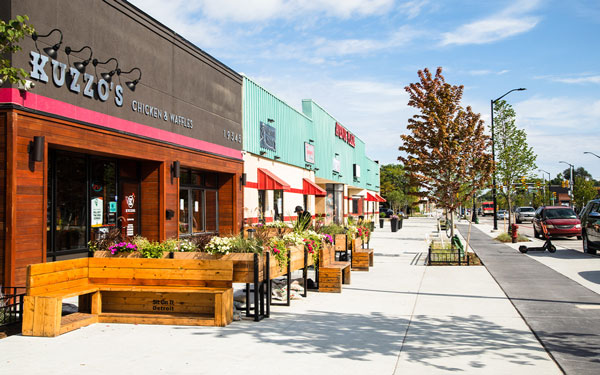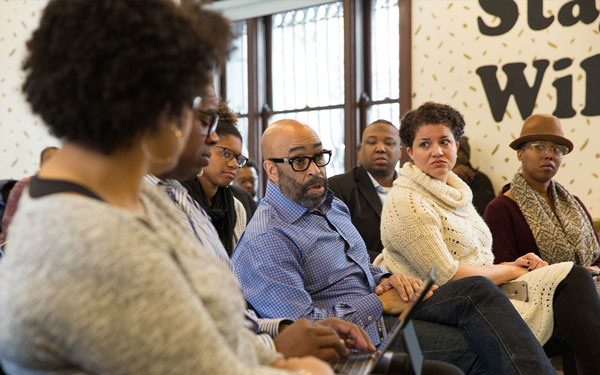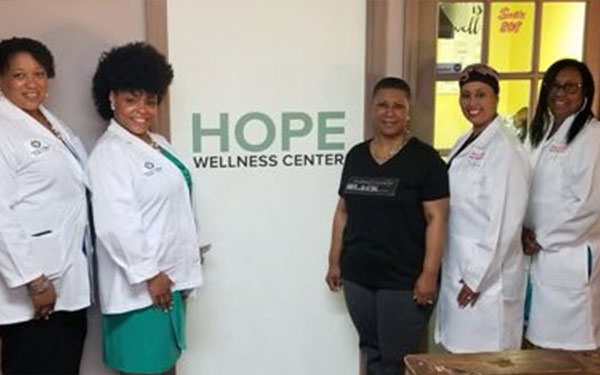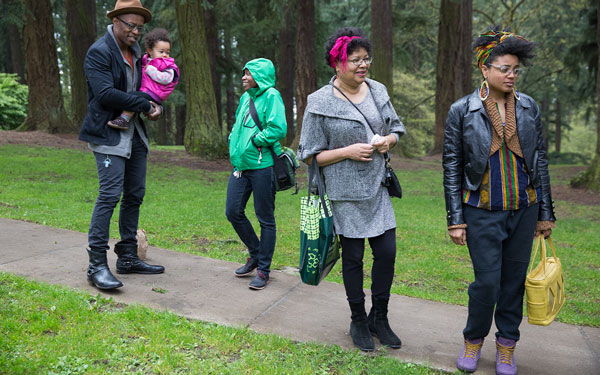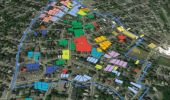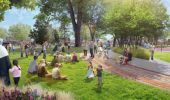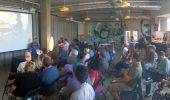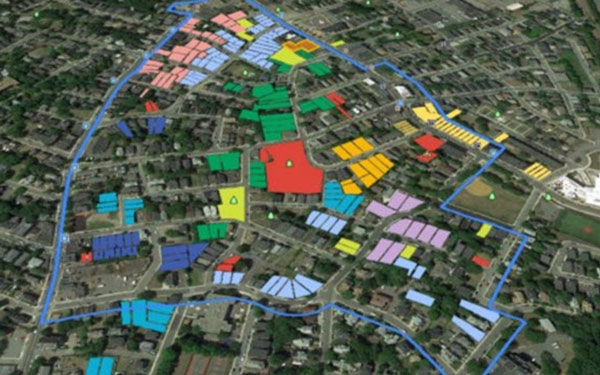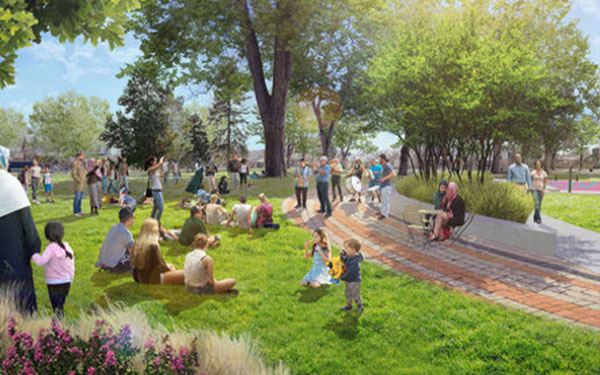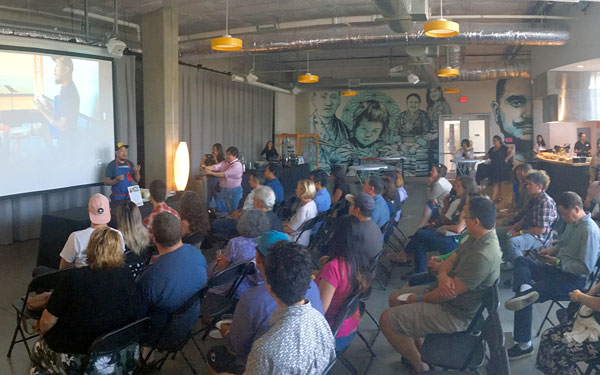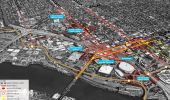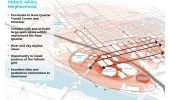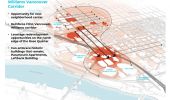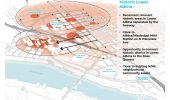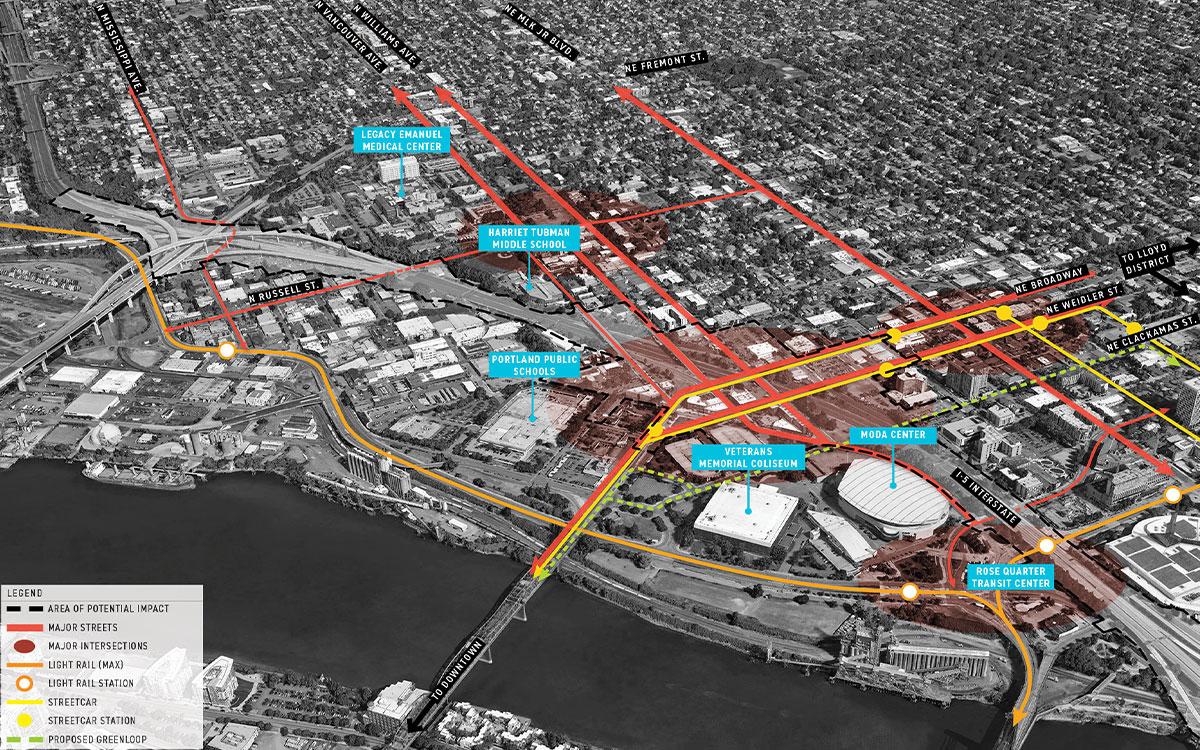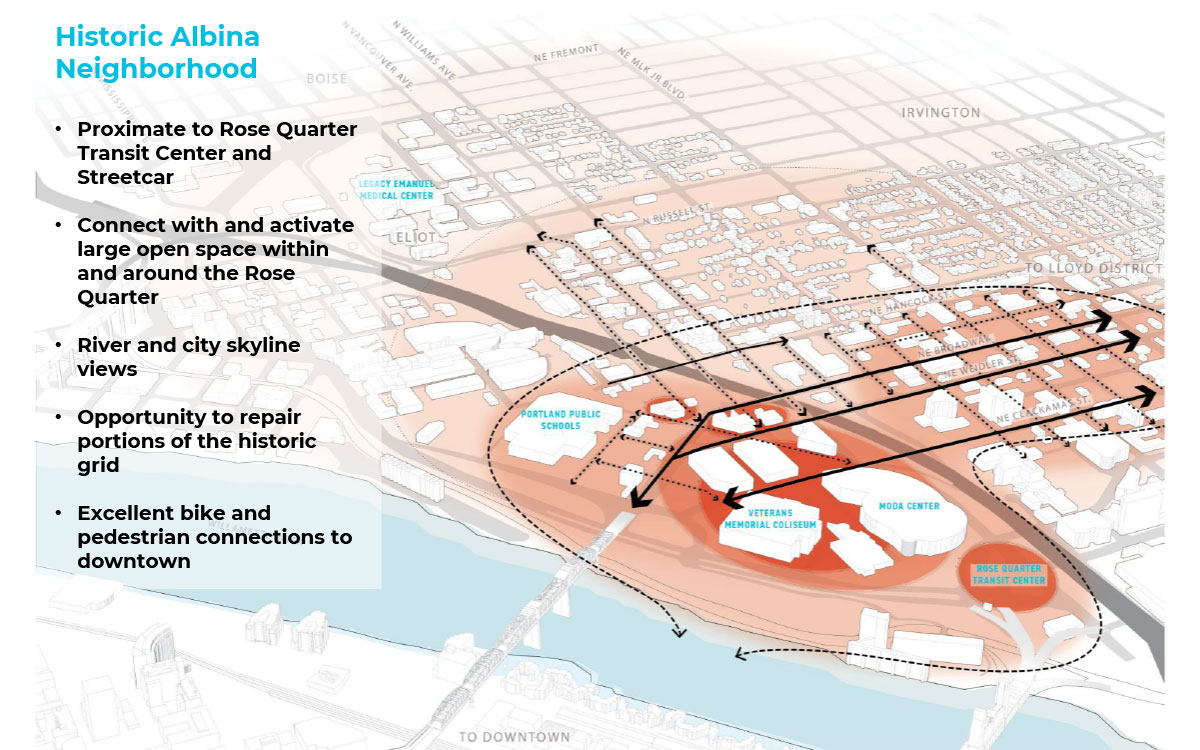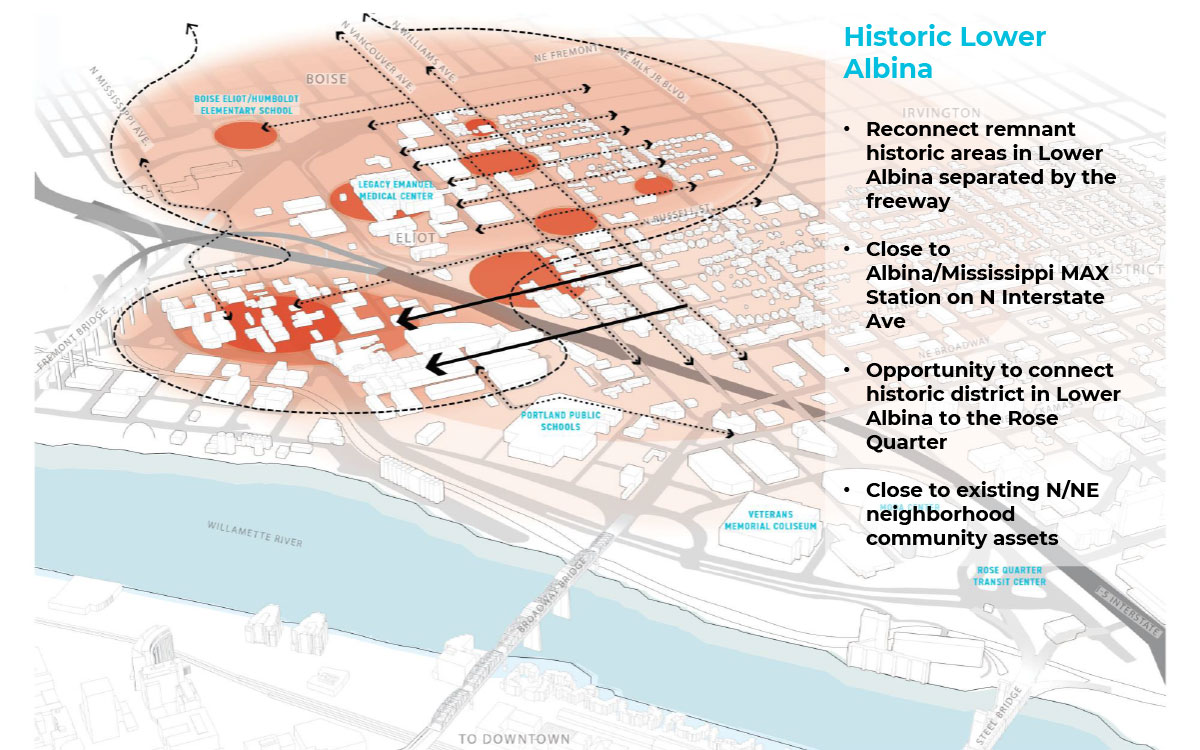Visit the pages on this site using the buttons below or click "Get Started" to move through the information in order.
Stations






= Page includes questions or opportunities for comment.
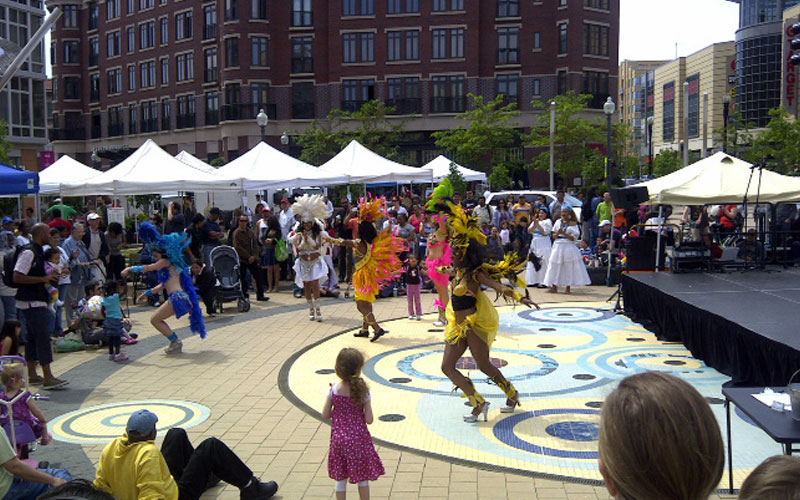
Vital community activity, Columbia Heights, Washington DC. (Image courtesy of ZGF Architects.)
Last year, in response to direction from the Governor and requests from local project stakeholders, the Oregon Transportation Commission directed the Oregon Department of Transportation to retain a consultant team of local and national urban design, engineering, and environmental experts to conduct an independent assessment of the highway cover designs included in the I-5 Rose Quarter Improvement Project. The requests from Metro, Multnomah County, City of Portland, Portland Public Schools and Albina Vision Trust shaped the creation of the independent cover assessment process.
Image gallery contents:
Existing Conditions
Area of potential impacts shown.
Environmental Assessment
Green space and development within the area of potential impact, analyzed in the Environmental Assessment (EA).
City of Portland
City of Portland preliminary concept for open space and development within the area of potential impact.
Albina Vision
Albina Vision proposal for open space and development within the area of potential impact.
Why Ask about the Community’s Vision for the Neighborhood and Covers?
The I-5 Rose Quarter Improvement Project may create new land on the highway covers that supports a variety of desired community goals and outcomes. Highway covers can also catalyze the development of land around them, either directly through purchasing that land for construction and returning it to a community use afterward, or indirectly through the delivery of new infrastructure that makes it easier to achieve community goals in the area.
The Independent Cover Assessment team will create scenarios to organize the neighborhood, its density, its mix of uses, and its functionality in and around the Albina/Rose Quarter area. These scenarios will provide opportunities for addressing restorative justice and climate action goals over the long term. Based on the Record Review and Executive Steering Committee’s Values and Outcomes, there is shared interest in a compact, service-rich, mixed-income neighborhood, with a strong community identity that showcases economic diversity and mobility and serves as a model of how to address climate change in the built environment.
With this in mind, we’re asking you to add your voice to a shared vision for a new neighborhood on and around the highway cover. Your input will be used to generate development scenarios that support restorative justice for the Historic Albina community and provide a unique place for everyone in the region to experience and enjoy.
The goal and theme for the first Online Open House is:
Goal: Listen/Assess
Theme: “How can highway covers support the community’s vision for neighborhood revitalization and provide restorative justice for the Historic Albina community?”
Learn more...
- Record Review (summary)
- Record Review Executive Summary (pdf)
- I-5 Rose Quarter Project Website (link)
(Click images to enlarge. Images courtesy of ZGF Architects.)
Image gallery contents:
Changed Community
Time lapsed aerial view of the Rose Quarter from the 1940’s to present day.
Zone of Influence
The Character of nearby neighborhoods may be connected and influence development on the highway covers.
Assets/Services
Services and landmarks are nearby may be connected to development and open space on the highway covers.
Background
Lower Albina was once a vibrant center of the Black community with housing, small businesses, activated street fronts, and strong community connection. Starting in the 1950s a series of urban renewal and transportation infrastructure projects displaced, often through eminent domain, Black residents and businesses.
- In the mid-1950s land was taken and cleared through eminent domain to build the Memorial Coliseum, displacing members of the Black community further north into N/NE Portland.
- In the mid-1960s, the construction of the I-5 freeway cut a path through the middle of the Historic Albina Neighborhoods including the Rose Quarter, causing additional displacement of Black and other residents and businesses.
- In the early 1970s Emanuel Hospital and the City of Portland cleared several blocks of homes and businesses around the hospital using eminent domain to expand the hospital’s campus. This third urban renewal event displaced and further scattered the nucleus of the Black business community that had been relocated and created a center of community life around the hospital campus.
Community activist groups worked to improve the quality of life in the N/NE neighborhoods on all fronts over the next quarter century and had some measure of success, evidenced by the residential housing market becoming more viable and attractive by the 1990s. However, this newly found marketability soon created additional waves of displacement for Black residents and businesses, slowly gentrifying N/NE Portland neighborhoods, and pushing rents and home prices out of reach for many Black Portlanders by 2010.
Despite all the public actions that have dismantled and scattered Portland’s Black community across the metro area over the last 70 years, N/NE Portland remains the core area supporting community connection for many Black Portlanders who were born and raised here and remember having a place that represented Black cultural identity. Most of the historic Black churches, Black social justice organizations and the largest Black social service agencies are still anchored in N/NE Portland despite the displacement of many Black residents; and there is still an ardent desire in many segments of the Black community to revitalize Historic Albina as a cultural center for Portland’s Black community.
Moving Forward
It is critical to restore community vitality in this Historic Albina neighborhood. Because this is a highway project, the Environmental Protection Agency evaluates the degree that community cohesion is achieved in the neighborhood due to highway cover improvements. Doing so requires identifying the key building blocks to support, preserve, and enhance the community connections between the remaining Black residents in the adjacent neighborhoods of the Albina/Rose Quarter area. Part of this restoration is determining how best to acknowledge and honor the long history of the Black people and industry in this part of Portland.
Reinforcing the historic community’s cohesion involves acknowledging the potential adverse effects that past public projects have had on the fabric and function of the remaining neighborhood.
Community cohesiveness is identified by a variety of factors, including but not limited to:
- An identifiable community boundary
- Concentration of people with similar economic and demographic characteristics in an area
- Common ethnic, cultural or racial identity of residents
- Shared experiences and values
- Critical mass of a specific demographic community’s population
- Concentrations of community-serving businesses
- Community-based activity centers and institutions that address the unique needs of residents in the area
- Active street life and pedestrian activity
- Shared gathering places for recreation, expression, celebration, and social connection
Active street life and economic activity around and across the highway covers can help repair the neighborhood that was divided many decades ago. Development scenarios will consider how the location and size of highway covers supports the neighborhood in delivering restorative justice and renewed community cohesion.
Questions
Image gallery contents:
Community-owned small business
Community-owned small business with widened sidewalks, Avenue of Fashion, Detroit, Michigan.
Community Cohesion
Customs House, Black entrepreneur lunch with Gov. Kate Brown, 2018.
Community Health and Wellbeing
Hope Community Wellness Center, Black Community Development Corporation (CDC), West Louisville, KY.
Access to nature
Access to nature in the City is critical to community health outcomes. Mount Tabor Park, Portland OR.
Background
Through our public record review for the project, the Independent Cover Assessment team recognized the importance of engaging the community harmed by past injustices to identify how to repair the harm, enable healing, and create a restorative path forward.
Moving Forward
Highway covers by themselves cannot deliver many of the community’s desired outcomes without partnerships between public, private and non-profit organizations. Moving forward, Black residents and businesses can create opportunities for restorative justice in this neighborhood. Success can be measured to the degree that community wealth, cohesion, and health outcomes are achieved and sustained.
Partner discussions might address:
Community Wealth
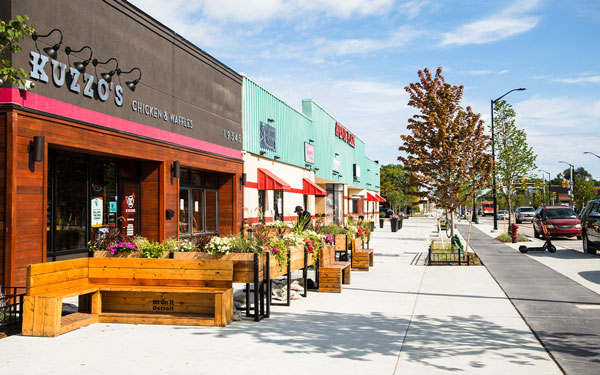
Community-owned small business with widened sidewalks, Avenue of Fashion, Detroit, MI. (Image courtesy of ZGF Architects.)
Support a neighborhood that supplies the means for community members to create intergenerational wealth opportunities through a local, circular economy to reduce disparities caused by serial bias and gentrification.
- Create affordable business space to own and lease.
- Provide affordable housing to own and rent.
- Provide opportunities for wealth generation through a community development corporation, other non-profit partnerships, cooperative ownership models, business development incubators, etc. where Black-owned businesses and residents can invest and thrive
- Use land banking or other development opportunities to foster public and private partnerships to support the historic community’s redevelopment vision for Albina.
- Maximize Disadvantaged Business Enterprise diverse workforce opportunities at every phase of the project to gain jobs, build capacity, and address specific Black/BIPOC contracting and service provider needs in Portland.
Community Cohesion
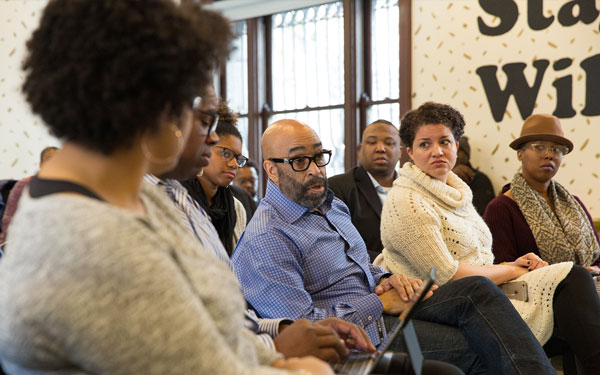
Customs House, Black entrepreneur lunch with Gov. Kate Brown, 2018. (Image courtesy of Intisar Abioto.)
Harness local and regional community assets to form committed partnerships to leverage environmental and socioeconomic ecosystems, and allow communities to heal, thrive and mature.
- Empower decision-makers and decision-making processes for those communities that have and still are experiencing systematic racism.
- Provide benefits to communities and individuals who have been harmed in the past.
- Provide access to other areas of the city for employment and services.
- Provide public realm spaces and facilities that support the Black community’s cultural identity and legacy in the area.
- Support the development of economic models of community resilience and sustainability.
Community Health
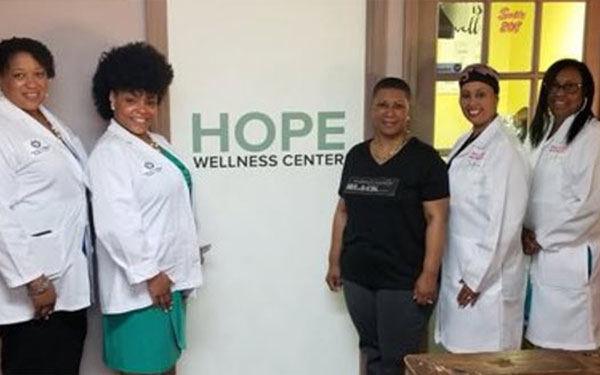
Community Health and Wellbeing: Hope Community Wellness Center, Black Community Development Corporation (CDC), West Louisville, KY.
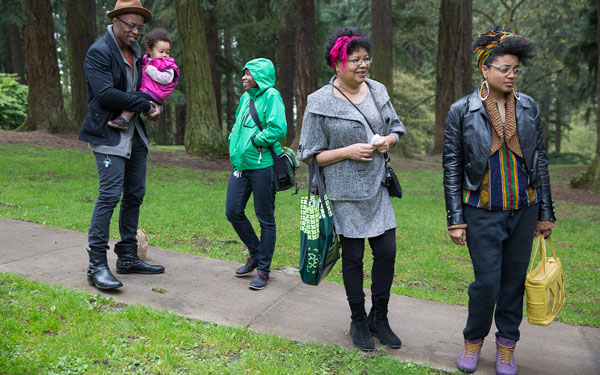
Access to green and natural environments provide physical and mental health benefits. Mount Tabor Park, Portland, OR.(Image courtesy of Intisar Abioto.)
Promote and improve human wellness to overcome chronic health conditions and create new spaces that promote a human-centered environment that strengthens social connections and includes room for physical activity, socialization, and relaxation; while also incorporating safe respite spaces that are beneficial for psychological health and healing.
- Promote family wage jobs in healthcare, and education.
- Create safe and healthy outdoor spaces for all ages.
- Coordinate the delivery of community and government heath related activities and services from facilities in the area.
Questions
Community Wealth
Stakeholders have identified wealth creation as an essential component to providing restorative justice. Which of these means of creating wealth do you think are most important to provide in the Albina/Rose Quarter neighborhood?
(Check up to 3.)Community Health
Of the following options for supporting community health, which of these do you think are the most important to be located in this newly restored neighborhood?
(Check up to 3.)Community Cohesion
Of the following options for supporting community cohesion which do you think would be the most impactful if provided in the Albina/Rose Quarter neighborhood?
(Check up to 3.)Image gallery contents:
Permanent Affordability
Community land trust, Dudley Street Neighborhood Initiative Boston, MA
Sun Valley Neighborhood Redevelopement
Sun Valley EcoDistrict (Non-profit organization) Denver, CO
Multi-Cultural Center with mural by local BIPOC artists
Cooking Demonstration at APANO Community Space, by RESOLVE Architecture + Planning, Portland, OR
Background
An essential part of this project is understanding the community’s desired outcomes for the neighborhood that can be supported by the highway covers. To achieve desired outcomes and not repeat the harm of the past public policy and programs, permitting in the area should be assessed and adjusted to form a new system of organizing private sector development and investment in the area, to ensure that the outcomes are restorative to the Historic Albina community.
Drone flight view of the project area, looking west and south. (Video courtesy of ZGF Architects.)
Moving Forward
How success is measured will be an important consideration in both the early years and the long term.
One important outcome might be to create a new governance system to support long-term financing of social, health, and economic opportunities for the Historic Albina community. This system could include subsidies for affordable housing and incubation of small local businesses as well as change how land is used to support innovation within the community. It could also include new connectivity and pathways to other areas of the historic Albina community that the Albina/Rose Quarter neighborhood was separated from with the building of the highway. Additionally, it could include new partnerships between the community, government, and the private sector that coordinate redevelopment efforts and actions.
The Independent Cover Assessment team will provide an assessment of each development scenario that shows how it performs relative to these types of desired outcomes within a new governance system using public and private partnerships. This assessment is intended to empower the community to make decisions and understand the trade-offs in different highway cover scenarios that support the community’s vision.
The development scenarios will:
- Consider how civic space is organized and used between the existing buildings.
- Consider how the ground-level building storefronts support adjacent outdoor activities and connections to nearby neighborhoods.
- Consider movement of people, vehicles and transit over the highway covers.
- Consider how air quality, noise, and safety in the area are improved.
- Consider how long-term partnerships catalyze, advance and sustain the community’s vision.
As the Independent Cover Assessment team prepares to analyze these elements in the neighborhood, help us to focus our effort by answering the following questions.
Questions
Image gallery contents:
Neighborhood Connections
The highway covers can improve existing corridors and make new connections that revitalize this area of the City.
Historic Albina Neighborhood
Opportunity areas connected by highway covers if located the near Rose Quarter.
Williams/Vancouver Corridor
Opportunity areas along Williams and Vancouver that could be connected by highway covers.
Historic Lower Albina
Opportunity areas improved or connected by highway covers near Tubman Middle School.
Background
The Executive Steering Committee is holding the Rose Quarter Improvement Project responsible for providing restorative justice with the design of the highway covers. The Independent Cover Assessment process will analyze information received from community stakeholders to create highway cover scenarios. Early in the process, it was recognized that a revitalized neighborhood, would be the most effective way to achieve restorative justice as described in the Executive Steering Committee Values and Outcomes. As the Executive Steering Committee deliberates the size and location of the highway covers that can help seed and catalyze a restorative neighborhood, you can add your voice to the process during the three planned online open houses.
Moving Forward
The proposed highway cover scenarios will connect neighborhood areas that were harmed by racist policy decisions supporting transportation and redevelopment goals for the region. In Work Session 2, the community will have an opportunity to consider ways the different surrounding neighborhoods can be drawn together to make a strong restorative district. There are three different neighborhood areas that can be connected by highway covers: 1) the Historic Albina Neighborhood, 2 the Williams /Vancouver Corridor, and 3). Historic Lower Albina. In the next Work Session, highway cover scenarios will be judged by how well buildings, civic space, and circulation connects these areas in a restorative way.
(Click to enlarge. Images courtesy of ZGF Architects.)
Timeline for Future Events
A summary of the feedback gathered during the first online open house will be organized to inform the development of scenarios that will be considered during the second online open house in April.
Following feedback and evaluation of the scenarios presented in the second online open house, the third online open house in June will consider what the Executive Steering Committee’s recommendation to the Oregon Transportation Committee should be.
Questions
Image gallery contents:
Diagram of project area
The highway covers can improve existing corridors and make new connections that revitalize this area of the City.
Historic Albina Neighborhood
Opportunity areas connected by highway covers if located the near Rose Quarter.
Williams/Vancouver Corridor
Opportunity areas along Williams and Vancouver that could be connected by highway covers.
Historic Lower Albina
Opportunity areas improved or connected by highway covers near Tubman Middle School.
Learn More...
Final Questions
Tell us About You
The following questions are optional and help the ICA public involvement team to continually aim for balanced and diverse involvement in our public processes.
For ADA (Americans with Disabilities Act) or Civil Rights Title VI accommodations, translation/ interpretation services, or more information call 503-731-4128, TTY 800-735- 2900 or Oregon Relay Service 7-1-1.
Si desea obtener información sobre este proyecto traducida al español, sírvase llamar al 503-731-4128.
Nếu quý vị muốn thông tin về dự án này được dịch sang tiếng Việt, xin gọi 503-731-4128.
Если вы хотите чтобы информация об этом проекте была переведена на русский язык, пожалуйста, звоните по телефону 503-731-4128.
如果您想瞭解這個項目,我們有提供繁體中文翻譯,請致電:503-731-4128

